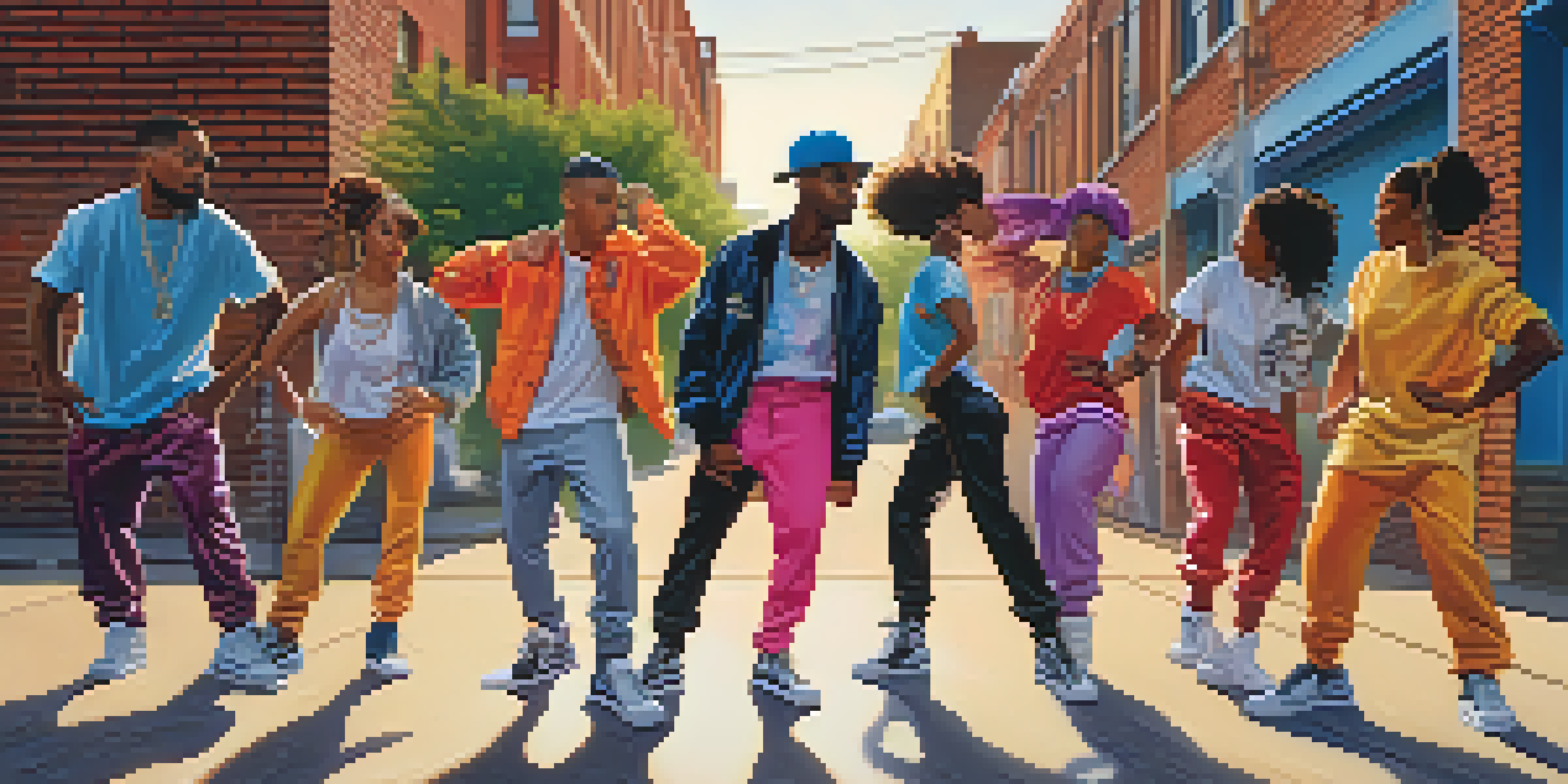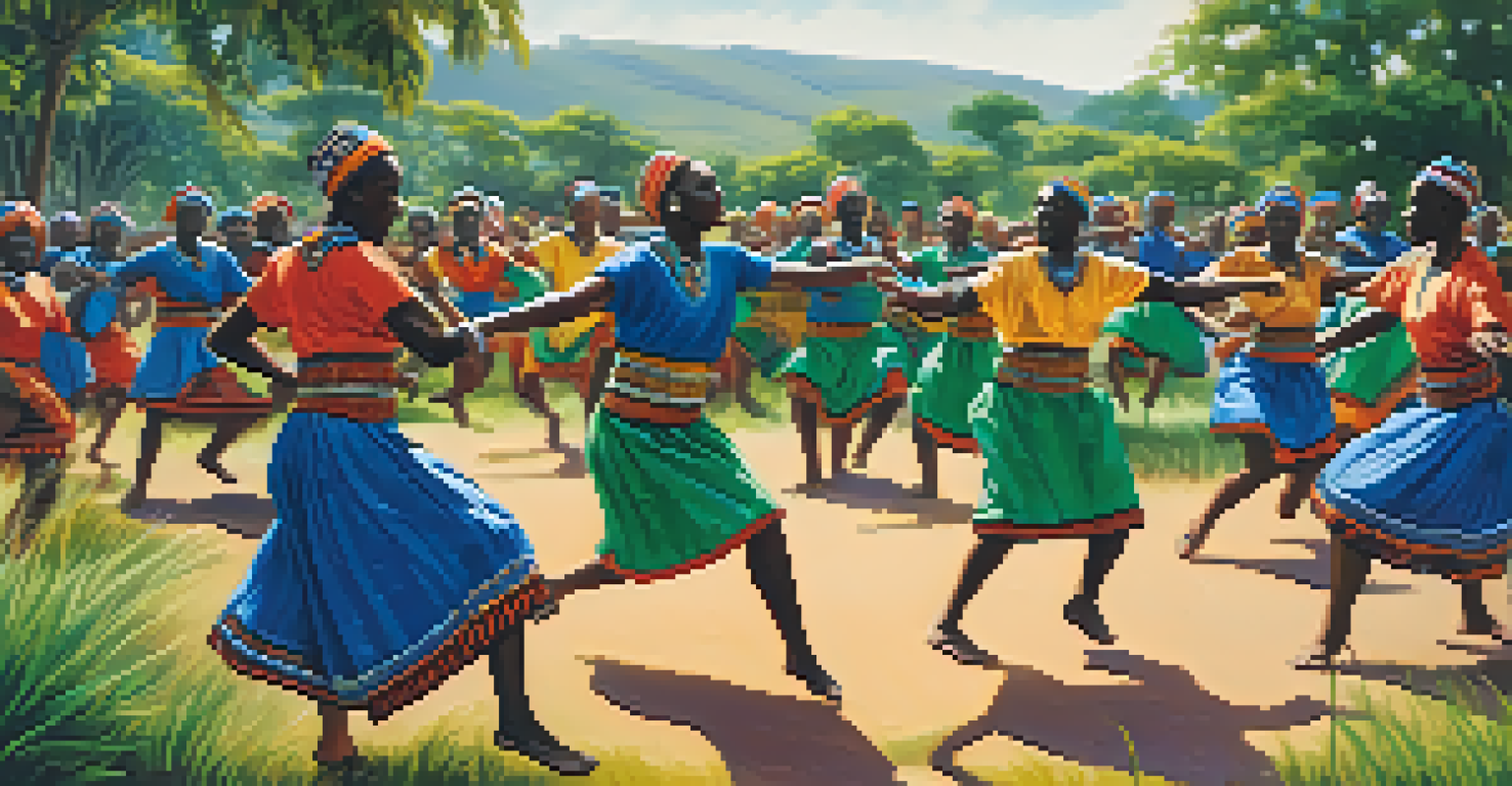The Evolution of Dance: Bridging Past and Present Cultures

The Roots of Dance: A Cultural Expression
Dance has been a part of human culture for thousands of years, serving as a form of expression and communication. From ancient rituals to celebratory gatherings, movement has united communities across the globe. For instance, the traditional dances of Indigenous peoples often tell stories of their heritage and values, reflecting a deep connection to their environment and spirituality.
Dance is the hidden language of the soul.
As cultures have evolved, so too has dance, adapting to shifts in societal norms and technological advancements. In many ways, dance acts as a mirror, reflecting the values, struggles, and joys of the people within a culture. Whether it’s the intricate footwork of Irish dance or the vibrant rhythms of Afrobeat, each style holds a piece of its cultural narrative.
This evolution highlights the importance of preserving these traditions while also allowing room for innovation. As new generations embrace different styles, they create a fusion of old and new, enriching the dance landscape and ensuring that cultural expressions remain lively and relevant.
Dance in Ancient Civilizations: A Historical Perspective
In ancient civilizations like Egypt, Greece, and India, dance served multifaceted purposes, ranging from religious rituals to entertainment. For example, the Egyptians incorporated dance into their religious ceremonies, believing it could appease the gods and ensure prosperity. Similarly, in ancient Greece, dance was integral to theatrical performances, highlighting its role in storytelling.

The significance of dance in these cultures underscores its power as a medium for expression and connection. It was not just about movement; it represented social status, community identity, and spiritual beliefs. The styles and forms varied greatly, yet they all shared a common thread: the ability to convey profound emotions and narratives.
Dance as Cultural Expression
Dance serves as a powerful medium for cultural expression, reflecting values, history, and community connections across various societies.
As we study these ancient practices, we uncover the foundations upon which modern dance has been built. The techniques, themes, and even the costumes have influenced contemporary forms, creating a rich tapestry that connects us to our past.
The Renaissance: A Dance of Revival and Innovation
The Renaissance period marked a significant shift in the world of dance, as art and culture flourished across Europe. This era saw the emergence of court dances, characterized by their elegance and formality, reflecting the social hierarchies of the time. Dances like the pavane and galliard became popular in royal courts, showcasing both skill and status.
Dance is the joy of movement and the heart of life.
Moreover, this period introduced the concept of choreography, with dance becoming more structured and intentional. Influential figures, such as Thoinot Arbeau, wrote manuals that detailed dance techniques and etiquette, further formalizing the art. This transition from improvisation to choreography paved the way for future generations to explore dance as a discipline.
The Renaissance not only revived classical forms but also sparked an interest in blending cultural influences. As travelers returned from their journeys, they brought new styles and rhythms, enriching the dance vocabulary and creating a vibrant exchange of ideas that still resonates today.
The Influence of African Traditions on Modern Dance
African dance traditions have profoundly influenced modern dance forms, bringing rich cultural narratives and rhythmic complexity to the forefront. From the energetic movements of West African dances to the fluidity of traditional dances in Southern Africa, these styles emphasize connection to the earth and community. These traditions are often embedded in storytelling, celebrating life events and ancestral heritage.
During the transatlantic slave trade, African dancers brought their practices to the Americas, where they evolved and blended with other styles, giving rise to genres like jazz and hip-hop. This fusion highlights the resilience of African culture and the ability of dance to transcend borders. As these new forms emerged, they retained elements of their origins while also adapting to contemporary influences.
Historical Evolution of Dance
From ancient rituals to modern styles, dance has evolved significantly, adapting to societal changes while maintaining its roots.
Today, the influence of African dance is evident in various modern styles, where the spirit of community and celebration remains strong. This ongoing legacy serves as a reminder of the power of dance to connect diverse cultures and foster understanding.
The Birth of Ballet: A Dance of Elegance and Technique
Ballet, originating in the Italian Renaissance courts, evolved into a highly technical and expressive art form. It was in France that ballet was refined, with figures like King Louis XIV playing a pivotal role in its development. The establishment of ballet schools and codification of techniques helped shape it into a disciplined and structured form of dance.
The grace and precision of ballet have made it a cornerstone of the dance world, influencing countless other styles. Its emphasis on technique, poise, and storytelling has paved the way for various modern interpretations. From classical performances to contemporary adaptations, ballet continues to inspire dancers and choreographers alike.
Moreover, ballet's ability to convey complex emotions through movement allows it to resonate with audiences across generations. As it evolves, ballet maintains its roots while embracing innovation, demonstrating the ever-changing landscape of dance and its role in cultural expression.
Hip-Hop Dance: A Cultural Movement of Expression
Hip-hop dance emerged as a vibrant cultural movement in the 1970s, rooted in African American and Latino communities. It began as a form of self-expression, often seen in street performances and block parties, where dancers showcased their individuality and creativity. This dance style has since evolved, incorporating various influences and techniques that reflect the diversity of its origins.
What sets hip-hop apart is its emphasis on improvisation and personal style, allowing dancers to express their unique identities. Styles like breaking, locking, and popping each have their own history and cultural significance, contributing to a rich tapestry of movement. This freedom of expression has made hip-hop accessible to people of all backgrounds, fostering a sense of community and belonging.
Future of Dance and Technology
The future of dance is being shaped by technology and diversity, enabling global connections and fostering innovative collaborations.
Today, hip-hop dance continues to thrive in various platforms, from dance competitions to music videos. It serves as a powerful tool for social commentary, addressing issues like identity, inequality, and resilience through movement, ensuring its place in both the dance world and cultural discourse.
The Future of Dance: Embracing Technology and Diversity
As we look to the future, dance is poised to evolve further, influenced by advancements in technology and a growing emphasis on diversity. Digital platforms have allowed dancers to connect globally, sharing styles and techniques that transcend geographical boundaries. This accessibility has led to a blending of cultures, fostering innovation and collaboration.
Moreover, technology is reshaping how we experience dance. From virtual reality performances to online dance classes, the ways in which audiences engage with dance are expanding. These developments offer new opportunities for artists to reach wider audiences and explore creative avenues that were previously unattainable.

In this evolving landscape, the importance of inclusivity and representation cannot be overstated. As more voices are heard and diverse stories are told through dance, the art form becomes richer and more reflective of the world we live in. The future of dance holds endless possibilities, inviting us all to join in the celebration of movement and culture.